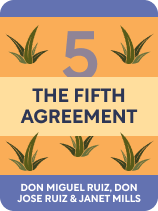

This article is an excerpt from the Shortform book guide to "The Fifth Agreement" by Don Miguel Ruiz. Shortform has the world's best summaries and analyses of books you should be reading.
Like this article? Sign up for a free trial here .
What is the path to enlightenment according to the Toltec? What do they mean by enlightenment?
The Toltec path to enlightenment involves three stages: the mirage of “the real world,” the seed of doubt, and the freedom of control. Authors don Miguel Ruiz and don Jose Ruiz describe these three phases as subjective realities. The Ruizes believe that, once you break through these stages, you reach total personal freedom.
Continue reading to understand the Toltec path to enlightenment.
The Toltec Path to Enlightenment
The naguals describe three subjective “realities” we can inhabit. Each subjective reality is a stage in the Toltec road to total personal freedom (or path to enlightenment), culminating in the ability to choose what we believe and thereby determine our own satisfaction and happiness.
In short, the naguals contend that our perception of reality—and therefore the way we think, feel, and behave—changes based on what we believe. As we begin to challenge and overcome the false “truths” we accepted as children, we grow progressively freer.
The following are the three stages of the Toltec path to enlightenment:
- Stage 1: The Mirage of “The Real World,” in which we take what we see at face value
- Stage 2: The Seed of Doubt, during which we challenge our perceptions and beliefs
- Stage 3: The Freedom of Control, in which we grow beyond what our society teaches
Enlightenment is a simple concept that’s easy to understand logically, but difficult to understand intuitively. It often evades explanation or description for the same reasons the naguals say that language is flawed; it’s a felt, lived experience. Many cultures and philosophies discuss the concept, however, and agree that an enlightened person has found freedom through understanding some fundamental truth. Until we “get it,” it’s hard to achieve lasting happiness.
To the Toltec, enlightenment is achieved primarily by discarding the set of beliefs that lead us to judge ourselves and others, returning to a state in which we’re content to live and let live. Each of us, they say, inhabits one of the three following stages—or perceptions—of reality. Most of us inhabit the first stage, but those who seek enlightenment—the third stage—must first progress through the second. Let’s look at each stage.
Stage 1: The Mirage of “The Real World”
Most of us, the naguals say, aren’t critical of what we perceive and learn. We trust what our culture, society, and teachers tell us, innocently and without reservation. We believe that what we’re seeing is all there is—we think we live in “the real world” and never realize that it’s only a mirage. This is the most common way to live, the naguals say. We’re handed a flawed belief system, and we accept it as-is.
Stage 2: The Seed of Doubt
To reclaim our freedom, the Toltec say, we must replace judgment with acceptance. In other words, we must stop demanding everyone be “better” and just love them as they are. To love ourselves as we are, and experience the world as it is. In short, the second stage of the Toltec path to enlightenment involves learning to accept what’s already here instead of focusing on how flawed it all is.
Stage 3: The Freedom of Control
The final stage in the Toltec path to enlightenment is the freedom of control. Let’s take a look at what enlightenment looks like for the Toltec:
The naguals say that the best stage of your life begins as soon as you completely stop judging. When you can allow yourself and others to simply exist, you lose the need to find yourself, to try to be someone else, or to “fix” yourself. Your personal story no longer describes a struggle against yourself, others, or the world—instead, it becomes a record of your existence, of the message you carry from the universe, to the universe. In short, because you’re no longer actively making yourself unhappy, you regain the childish freedom of being what you are without burden, expectation, or demand.
(Shortform note: Like the Ruizes, the Tao Te Ching says enlightenment is about living in the here and now, following the natural pull of your moment-to-moment experience. It’s about being at peace with the reality you live in—without expectations, self-consciousness, or attempts to control the actions of others. Similarly, the Bhagavad Gita explains that an enlightened person is content to exist in every moment, believing that their purpose is simply to be a part of this world. In short, there aren’t any rules; you’re free to simply experience the moments you get to experience.)
What to Do When You’re Enlightened
In doubting and re-examining our beliefs about reality, as the naguals recommend, we reclaim the power to decide for ourselves what we “should” be, how we’ll behave, what we care about, and why. You may still feel that you should dress nicely for work, but instead of that belief being an unthinking obligation, it’ll be a decision you make—and you’ll have your own reasons to back it up. This is a major component of the freedom of control—it’s the power to shape your own reality. You’ll never again be forced to do something just because you think you’re supposed to. It’ll be genuinely up to you.
Once you’ve reached this point, you’ve eliminated the influences—both external and internal—that drove your unhappiness. Most of us want more than that, though: We want to be happy. How do we do that? According to the Toltec, happiness is found through connection and service. When you find your peace and no longer feel driven to fix, acquire, and win, the naguals suggest it’s natural to discover desires to give, share, and experience cooperatively.
| Living an Enlightened Life Other than connecting with and serving others, what should you do with your newfound freedom? The Ruizes don’t say, but Taoist philosophy provides recommendations on how to spend the time you’re no longer wasting on trying to live up to expectations. For example, the Tao Te Ching suggests embodying “the supreme virtue,” putting aside all personal perspectives or biases and making decisions based upon the flow and call of the universe only. Remember that in the Tao, there is no good, evil, right, or wrong—only what is. When you embody the supreme virtue, you help someone up after they fall simply because you feel like it—it doesn’t matter who they are or what you think; just that you feel drawn to act. To the Tao, that’s the best reason to do anything. In both Toltec and Taoist philosophy, what you do when you’ve found your freedom is up to you. For the rest of your life, you only have to do exactly what you want to do. |
Which stage of the Toltec path to enlightenment might you be in today?

———End of Preview———
Like what you just read? Read the rest of the world's best book summary and analysis of Don Miguel Ruiz's "The Fifth Agreement" at Shortform .
Here's what you'll find in our full The Fifth Agreement summary :
- The five “agreements” to make with yourself that adjust your outlook
- How to rediscover your true self and recapture the freedom you felt as a child
- A five-step process to escape the mirage of “the real world”






